Milan Things to Do: Top 10 Must-See Attractions
Milan, a bustling metropolis renowned for its fashion, finance, and cultural heritage, offers a treasure trove of experiences for travelers seeking adventure and inspiration.
While many know it as a business hub, this vibrant city is steeped in history and brimming with unique attractions that cater to every type of visitor.
From stunning architecture to world-class museums, Milan things to do abound at every turn.
Whether you’re wandering through the cobblestone streets of the historic center or indulging in the culinary delights of local eateries, Milan promises unforgettable moments.
Join us as we explore the top 10 must-see attractions and activities that will make your trip to this iconic city truly remarkable.
Table of Contents for Milan Things to Do
Milan FAQs – Discover the Secrets of this Enchanting City!
Looking for answers about Milan? Look no further! Get ready to unravel the mysteries of this captivating destination. Delve into our curated list of frequently asked questions about Milan, designed to make your travel experience extraordinary. Discover the best things to do in Milan and unlock a world of excitement and adventure. Explore Milan like a local and create unforgettable memories. Get started now!
What are the top attractions to visit in Milan?
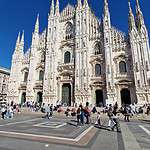
Here is our list of things to do in Milan: Castello Sforzesco (Milan castle Sforzesco), Terraces of the Cathedral on the Duomo rooftop, Galleria Vittorio Emanuele II, Teatro la Scala, Monastery of Santa Maria Delle Grazie, a UNESCO World Heritage Site, which houses the iconic ‘Last Supper’ by Leonardo Da Vinci, Palazzo Reale, Villa Reale, I Navigli, Museum of science and technology, Branca Tower.
What are the most popular things to do in Milan with kids?
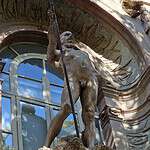
“Museo delle illusion” or Museum of illusions, Museum of science and technology, aquarium.
What are some fun things to do in Milan?
One idea is to visit the “Museo delle illusion” or Museum of illusions. It’s a museum for families dedicated to optical illusions, with exhibits of holograms and mirrors.
What are the best free things to do in Milan?
You can go to the Castello Sforzesco (Milan castle Sforzesco) and visit it from the outside. You can also enter the courtyard. Then you can go to Piazza del Duomo so you can see the amazing Duomo from the outside. You can also walk in the Galleria Vittorio Emanuele II. For the evening, a beautiful walk along the Navigli is a great idea. The Naviglio Grande area is the beating heart of Milanese nightlife.
What are the top things to do in Milan?
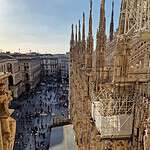
Here is our list of things to do in Milan: Castello Sforzesco (Milan castle Sforzesco), Terraces of the Cathedral on the Duomo rooftop, Galleria Vittorio Emanuele II, Teatro la Scala, Monastery of Santa Maria Delle Grazie, a UNESCO World Heritage Site, which houses the iconic ‘Last Supper’ by Leonardo Da Vinci, Palazzo Reale, Villa Reale, I Navigli, Museum of science and technology, Branca Tower.
What are the top things to do near Milan?
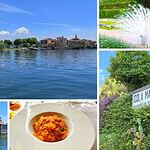
Day Trips From Milan to Lake Maggiore.
From Milan to Stresa
Stresa is a gorgeous town on lake Maggiore. It has beautiful gardens, luxury hotels, and a beautiful view of the Borromean Islands
From Milan to Laveno Mombello
Laveno is a very nice town on lake Maggiore and you can arrive here from Milan by train in about one and a half or 2 hours. Laveno Mombello isn’t as rich as Stresa but it has a “very Italian style” and you can do very interesting tours from here.
Day Trips From Milan to Lake Como
One of the cutest towns in Lake Como is Bellagio. It takes about one hour and a half from Milan to get here.
What are the top Milan things to do for first-time visitors?
First-time visitors should explore the iconic Duomo di Milano, visit the breathtaking Galleria Vittorio Emanuele II, and admire Leonardo da Vinci’s The Last Supper at Santa Maria delle Grazie.
Are there any free Milan things to do?
Yes, you can enjoy free walking tours, relax in Sempione Park, and visit the stunning Basilica di Sant’Ambrogio without spending a dime.
What Milan things to do are family-friendly?
Families will love the Museo Nazionale della Scienza e della Tecnologia, the interactive exhibits at the Museo del Fumetto, and exploring the fun playgrounds in Sempione Park.
What are some Milan things to do in the evening?
Experience the vibrant nightlife at the bars in Navigli, attend an opera at La Scala, or enjoy a sunset stroll along the canal for a magical evening.
What cultural Milan things to do should I not miss?
Don’t miss the stunning works at Pinacoteca di Brera, the historic Castello Sforzesco, and the captivating performances at Teatro alla Scala.
What Milan things to do are perfect for art lovers?
Art lovers should visit the contemporary exhibits at Museo del Novecento, the masterpieces at Palazzo Reale, and the street art in the Isola district.
What Milan things to do are must-see during the holidays?
During the holidays, visit the Christmas markets at Piazza Duomo, enjoy the festive lights in the city, and see the stunning holiday window displays at Galleria Vittorio Emanuele II.
What Milan things to do guarantee a local experience?
To experience Milan like a local, join a cooking class for risotto alla Milanese, explore the local eateries in the Porta Romana district, and attend a football match at San Siro Stadium.
Milan things to do
Here is our list of things to do in Milan.
- Castello Sforzesco (Milan castle sforzesco)
- Terraces of the Cathedral on the Duomo rooftop https://ticket.duomomilano.it/en/
- Galleria Vittorio Emanuele II
- Teatro la Scala https://www.museoscala.org/en/visit/
- Monastery of Santa Maria Delle Grazie, a UNESCO World Heritage Site, which houses the iconic ‘Last Supper’ by Leonardo Da Vinci.
- Palazzo Reale
- Villa Reale
- I Navigli
- Museum of science and technology
- Branca Tower
Other things to visit
- Sempione Park
- ‘900 Museum
- Aquarium
- La rinascente
Let’s go to deepen together some of these things to see in Milan.
Sforza Castle: The Castle of Milan
Discover a treasure trove of cultural wonders within the magnificent walls of Castello Sforzesco. Immerse yourself in the captivating world of Milan’s rich heritage by exploring its esteemed museums, curated collections, and esteemed cultural institutes. Embark on an unforgettable journey through time and unlock endless opportunities for exploration and enlightenment. Milan things to do await, so indulge your wanderlust and let Castello Sforzesco be your gateway to the vibrant tapestry of this enchanting city.
What is the history of the Castle of Milan?
The origins of the Castle of Milan, also known as the Castle of Porta Giovia (Jupiter Gate), is linked with the time of the Visconti rule. In fact, the Lord of Milan Galeazzo II Visconti, in 1368, commissioned a fortified structure to be built beside the city walls.
His successors, Sian Galeazzo (1385-1402) and Filippo Maria Visconti (1412-1447) reinforced and enlarged the castle and established their residence here. Unfortunately, the castle was later partially destroyed during the years of the Ambrosian Republic.
The Castle was later rebuilt by Francesco Sforza: the skilled military leader and Duke of Milan from 1450-1466. Francesco Sforza not only rebuilt the castle but also decided to rebuild it on a more grandiose and majestic scale. To do that, entrusted the project to famous engineers and architects such as Giovanni da Milano, Jacopo da Cortona, Bartolomeo Gadio, and Antonio di Pietro Averulino, also known as “il Filarete”.
The Castle, enriched and enlarged, could provide an elegant setting for the Renaissance court of Milan. The protagonist of this period were Galeazzo Maria Sforza (1466-1476) and Ludovico Maria Sforza “il Moro”, who was deposed by the French in 1499. The artists employed at the Sforza court included Donato Bramante and Leonardo da Vinci.
From 16th to 19th century, the Castle was used by foreign forces as a barracks, stables and storage space. It underwent profound transformations during the long period of Spanish domination (1535-1706) when the sumptuous royal residence was turned into a star fort.
It remained a fortress until the arrival of Napoleonic forces in 1796. In 1800, Napoleon began the demolition of the fortified walls to make way for an area to be used in a grandiose project, the Bonaparte Forum.
Later, the unification of Italy sparked a fierce debate as to whether the Castle was to be saved or demolished, and only at the end of the 19th century did the desire to restore the monument prevail.
The work was entrusted to the architect Luca Beltrami who, between 1893 and 1911, rebuilt, among other things, the main tower, known as the “Tower of Filarete”, which had collapsed following an explosion in 1521.
Beltrami created the necessary spaces inside the tower to transform the entire building into a receptacle of the city’s historical memory.
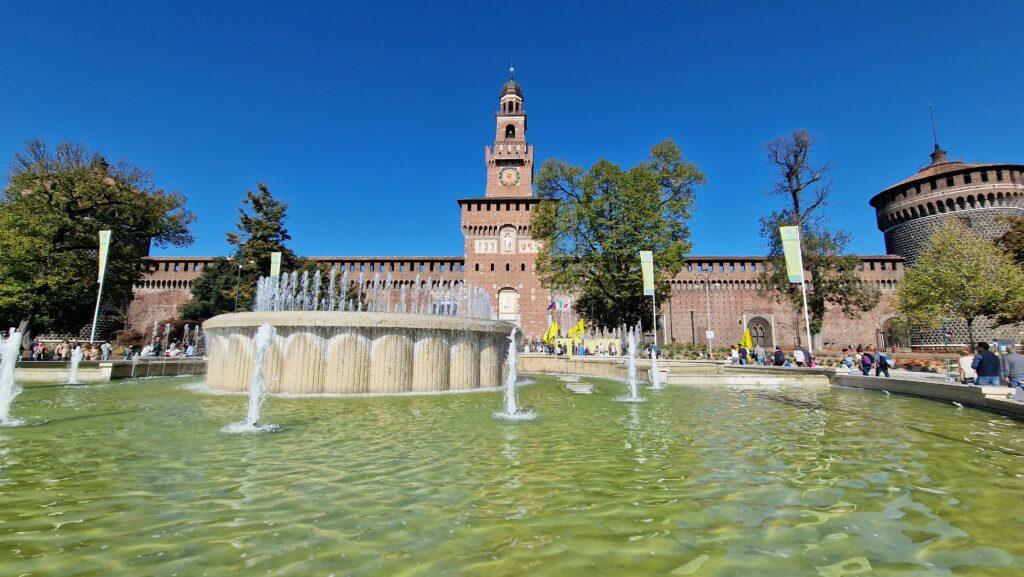
The Porta Giova
This name was the name belonging to the city walls of the communal era (12th century behind which Galeazzo II Visconti, in 1368, built the first nucleus of the Castle, the Castrum Portae Jovis, between the rural territory and the inhabited area.
Galeazzo II Visconti had defined the canons of Visconti’s military architecture with the construction of the Pavia Castle, which had already begun a few years earlier.
We can learn what northwestern access to Milan was like, which opened between the Porta Vercellina and the Pusterla Delle Azze, thanks to a fourteenth-century plan for the city. This plan is taken from a codex containing works by the Milanese chronicler Galvano Fiamma and describes it as a small door with a single turreted and crenelated arch.
Gian Galeazzo Visconti succeeded his father in 1385 and added a “citadel” towards the countryside to the first fortified nucleus. In this way, the ancient urban wall was incorporated into the building and its relative moat lost all defensive functions, thus becoming a “dead moat”.
After 1412 Filippo Maria Visconti joined the two parts of the Castle with the demolition of the wall.
At the point where the ancient Pusterla Giovia presumably stood today, there remains a passage in the shape of a square enclosure equipped with two doors: one towards the Cortile Delle Armi protected by a drawbridge and one towards the Ducal Court.
The Duomo Cathedral
Discovering Milan Cathedral is an absolute must for travelers seeking a quintessential experience in the city. Unveiling the essence of Milan, this iconic monument stands tall as a symbolic masterpiece. Delve into the wonders of this architectural gem and uncover the secrets it holds. Elevate your Milan itinerary with a visit to this majestic cathedral, and let its grandeur and history leave an indelible mark on your journey.
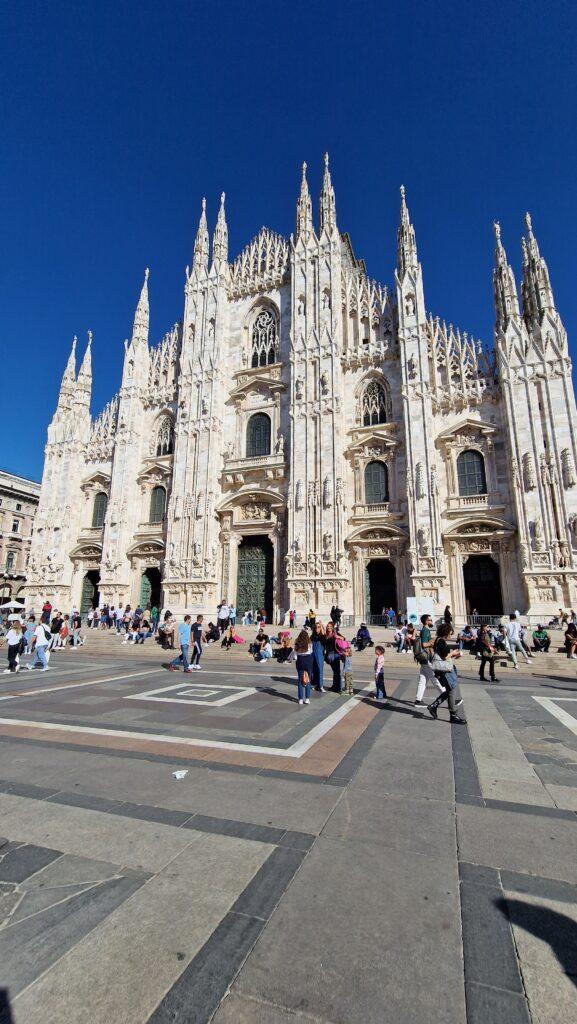
Who ordered the construction of the Milan Cathedral?
The construction of the Milan Cathedral began in 1386 by the will of the then lord of Milan, Gian Galeazzo Visconti.
When did the construction of the Milan Cathedral begin, and when was it completed?
The construction and completion of the Milan Cathedral took centuries. Here are the main historical stages of its construction:
- 1386: Construction of the Cathedral begins
- 1387: The Veneranda Fabbrica del Duomo di Milano is officially established
- 15th and 16th centuries: The apse, the first spire, the transepts, the Tiburio, and the Amedeo spire are completed.
- 17th and 18th centuries: The main spire is completed.
- 1774: The Madonna is hoisted on the Spire Maggiore.
- 19th (19th) century: Most of the statues and spiers are made.
- 1965 The construction of the Milan Cathedral is completed with the inauguration of the last door.
The majesty of the Duomo
As soon as you see the Duomo of Milan, you are captured and fascinated by the grandeur of this building. This grandeur and magnificence are also evident from the following data:
- 3400 statues
- 200 bas-reliefs
- over 3600 characters
- 55 stained glass windows for a total area of 4250 square meters
- 135 spiers
- 150 gargoyles
- 158 in external length
- 93 meters external width
- 11,700 square meters of internal surface
- 96 giants
- 108.5m high from the ground.
What is placed at the highest point of the Milan Cathedral?
The Madonnina is the highest point of the Milan Cathedral. It was placed on top of the Spire Maggiore, 108.5 meters above the ground, at the end of December 1774.
The statue is 4.16 meters high and supported by a stainless steel frame. It is empty inside and covered outside with embossed and gilded copper plates.
The Madonna statue was made from Giuseppe Perego’s wooden model. Giovanni Battista Varino, the blacksmith who made the original internal iron support, is now kept in the Duomo Museum.
Vittorio Emanuele II Gallery
Galleria Vittorio Emanuele II, whose construction occurred between 1865 and 1877, is a mesty-covered passage connecting Piazza Duomo to Piazza della Scala. Since its inauguration, it has been considered the “living room of Milan” due to the presence of luxurious clubs and shops.
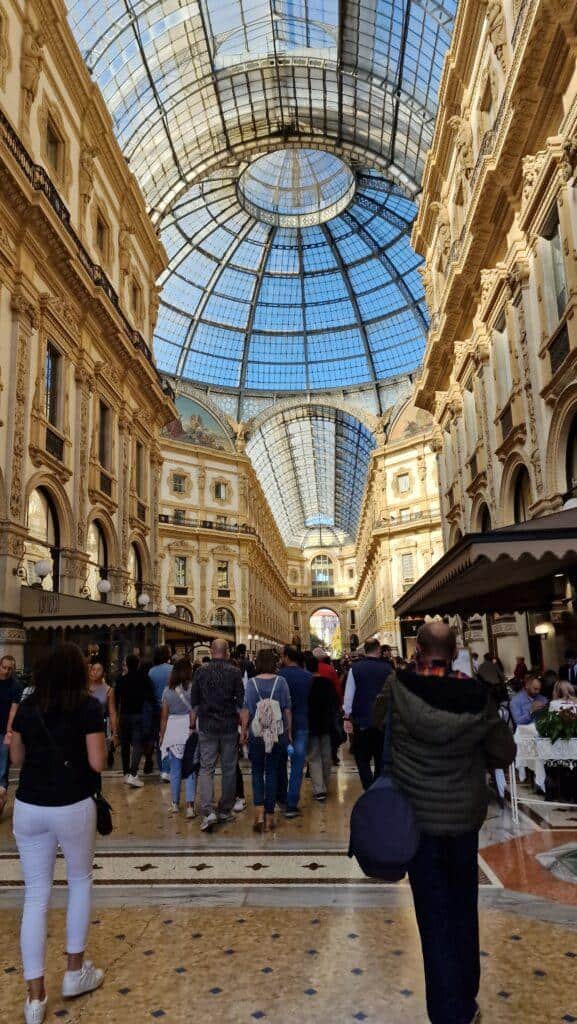
Terraces of the Cathedral on the Duomo rooftops
Visits to the cathedral terraces allow visitors to climb on the roof of Milan Cathedral to appreciate its architecture more and enjoy unique views of the Piazza del Duomo and the city’s skyline.
To go up to the Cathedral’s Terraces, you have to buy an entrance ticket and the best way to do it is online on the official website: https://ticket.duomomilano.it
Purchasing tickets online allows you to go directly to the cathedral and the relative access points for the ascent to the terraces.
You can choose whether to take the lift or walk via the stairs when purchasing your ticket. Depending on the choice made and the ticket purchased, you must go to the access point dedicated to the ascent by stairs or lift.
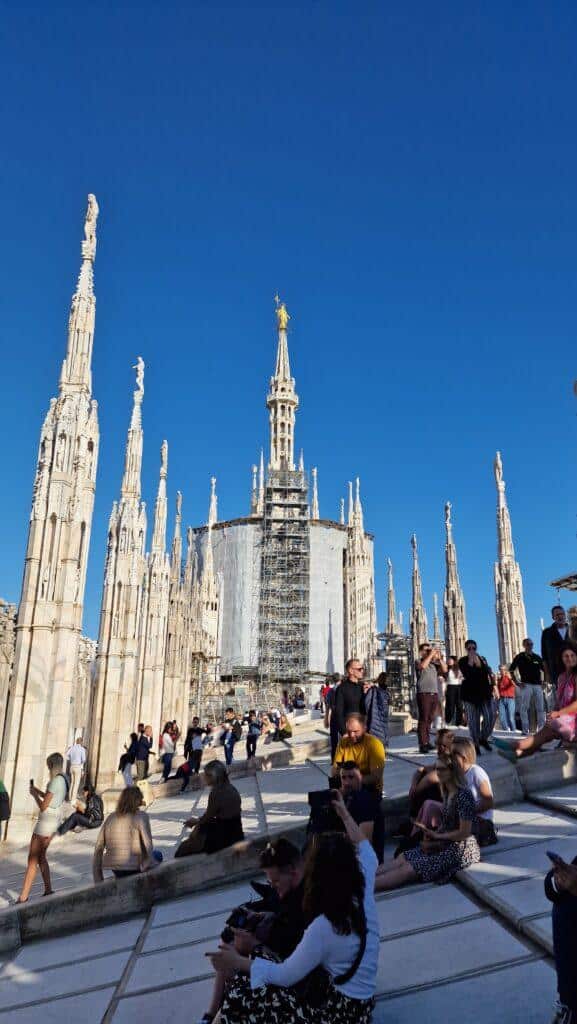
However, the descent from the terraces of the cathedral is always via stairs, even if you have chosen and purchased the ticket for the lift.
Royal Palace
The Royal Palace of Milan is located in Piazza Duomo. For many centuries, it was the seat of the government of the city of Milan and the Kingdom of Lombardy-Veneto. It was then the royal residence until 1919. Today, this splendid building has become the venue for exhibitions.
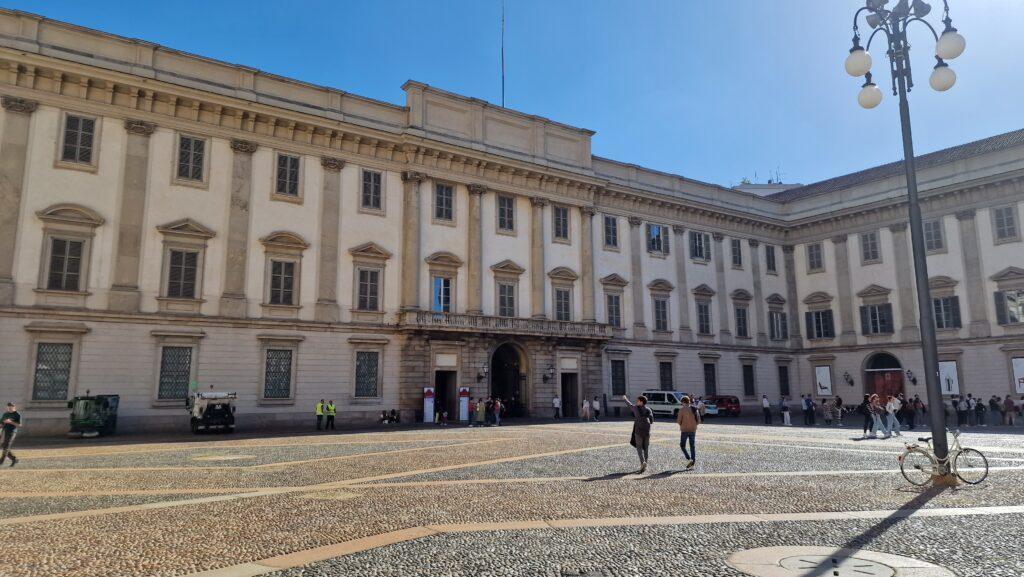
Those who visit the exhibitions at the Royal Palace appreciate the works on display and the palace’s beauty with its large rooms and chandeliers of rare beauty.
The Navigli
The Navigli was a precious system of navigable canals that allowed Milan also to be connected by water to Lake Maggiore, Lake Como, and the Po ‘which in turn has its outlet in the Adriatic Sea.
We can therefore imagine the importance that these channels have had in the past for the transport of goods. The canals were also a precious water resource for the city and the hinterland. Leonardo da Vinci also contributed to this system of canals.
The heavy marble used for the construction of the Milan Cathedral was made to pass along these canals.
Today, unfortunately, little remains of this network of canals which is still a fundamental part of the city but for a different reason.
The Naviglio Grande area is the beating heart of Milanese nightlife. Here, you can find excellent restaurants and places to spend a nice evening. Many places in this area offer happy hour: for the purchase of a drink (only one drink), which is sometimes at a fixed price and sometimes paid according to what is ordered, you can also eat from a buffet.
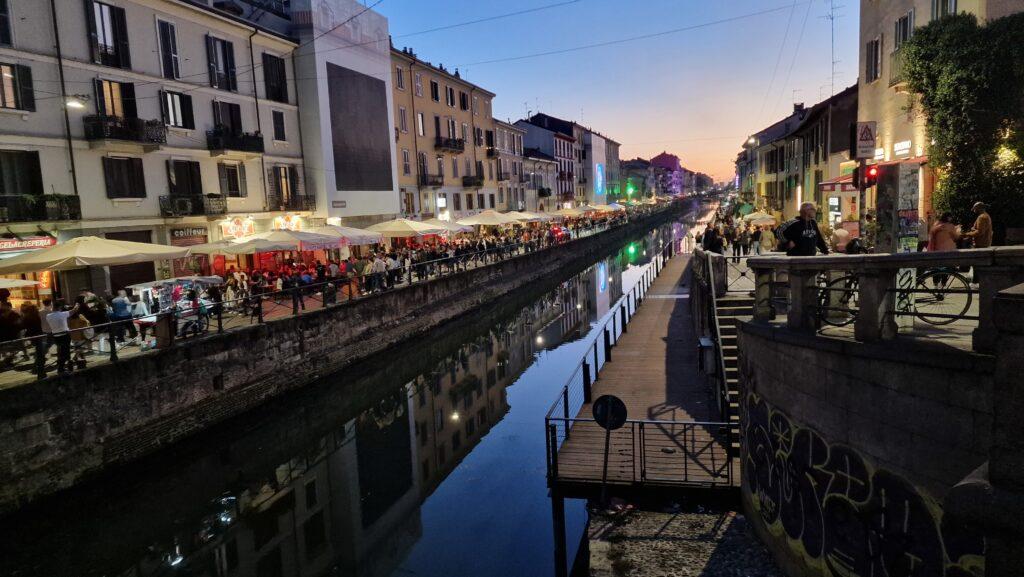
This is a great solution if you don’t want to spend much on dinner but still want a nice evening in Milan.
The Milan Aquarium
The Milan aquarium is located inside a historic Viennese Art Nouveau building. It was designed by the architect Sebastiano Locati as a pavilion for the 1906 Milan International Exposition.
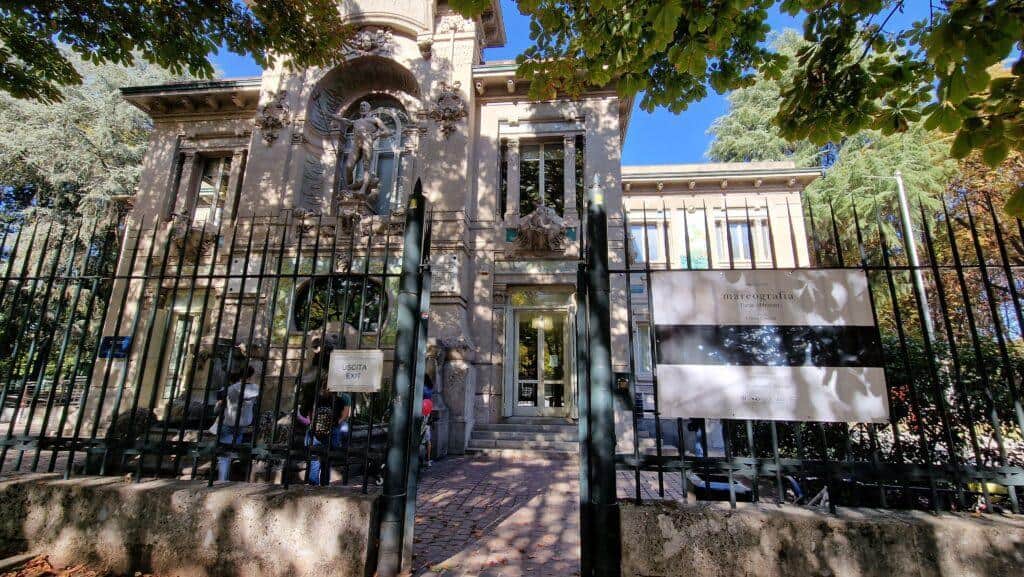
The Milan aquarium has nothing to do with large aquariums like the one in Genoa: the path of the tanks is short and the tanks are compared to other small aquariums.
The interesting thing about this aquarium, however, is that the itinerary aims to make known the fish present in the waters of the local area. In fact, it follows the path of the water from the alpine springs up to 30 meters of sea depth, following the river Adda.
The visit to this aquarium is not surprising in terms of the fish present but it is still useful in order to enrich one’s personal culture with respect to one’s own territory or, in any case, to the territory one is visiting.
Museum of the twentieth century
The Museo del Novecento is located in Piazza Duomo and houses works from the twentieth century.
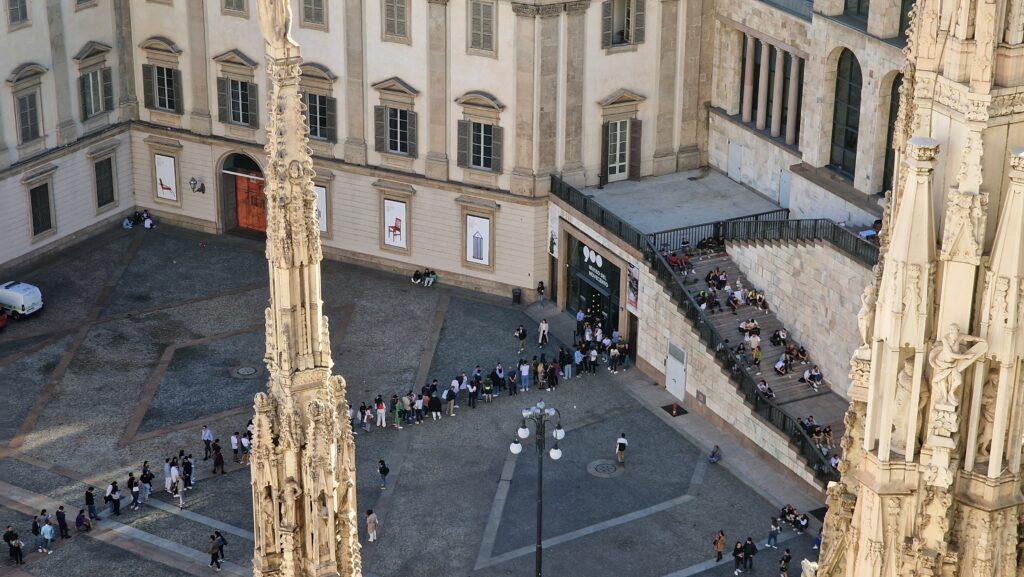
Sempione Park
Parco Sempione, nestled within the heart of Milan, is a lush oasis waiting to be discovered by travelers. This captivating green area, surrounded by the charming walls of the city, offers a serene escape from the bustling urban landscape. Situated in close proximity to the magnificent Sforzesco Castle, it invites visitors to immerse themselves in the harmony of nature and history, creating an unforgettable experience that captures the essence of Milan’s rich heritage.
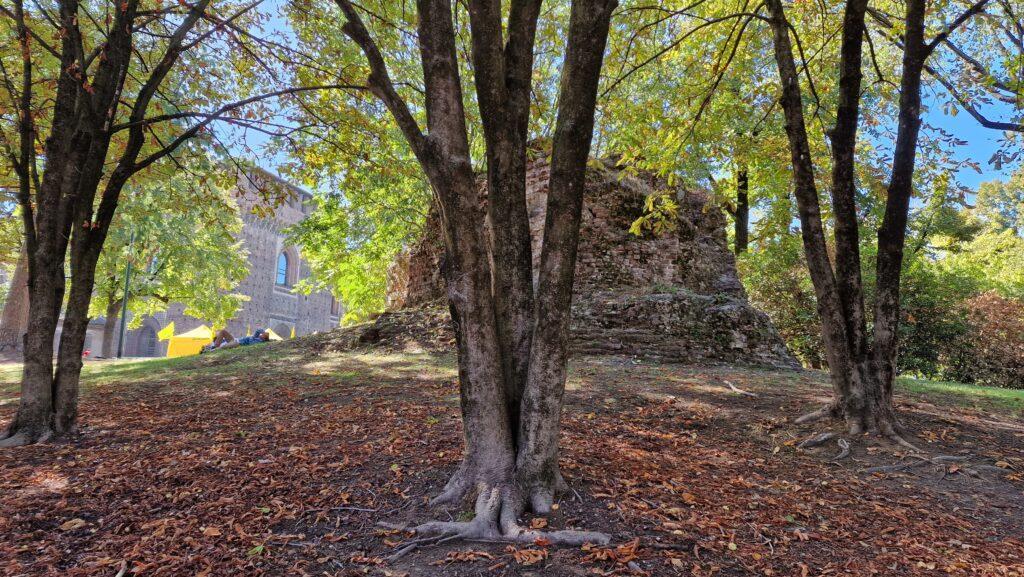
Rinascente Store
Rinascente, a renowned store in Milan, is a must-visit for travelers seeking a unique shopping experience. While it offers a wide range of shopping options, what truly sets it apart is the eclectic mix of offerings within its walls. Beyond the racks of fashion, you’ll discover a hidden gem—a vibrant bar that beckons you to savor a refreshing drink amidst the bustling cityscape. Shop, explore, and indulge in the unexpected delights Rinascente offers.
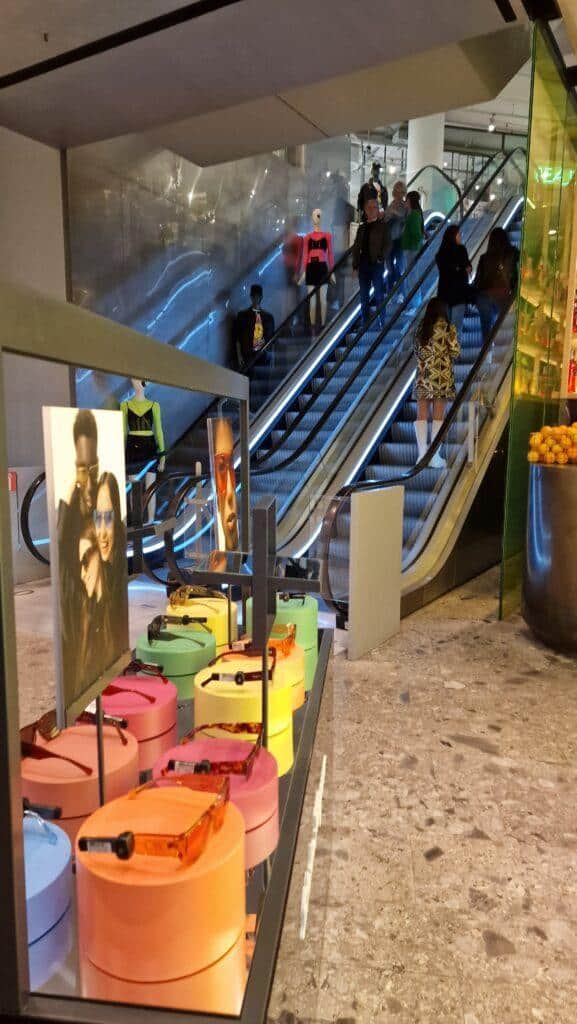
Where to eat without spending a lot?
Here are some places where you can eat well without breaking the bank.
Near Piazza Duomo
If you want to eat something good during your visit to Piazza Duomo without spending too much, you can go to the Panzerotteria Il Prisco.
Milan Metro Map
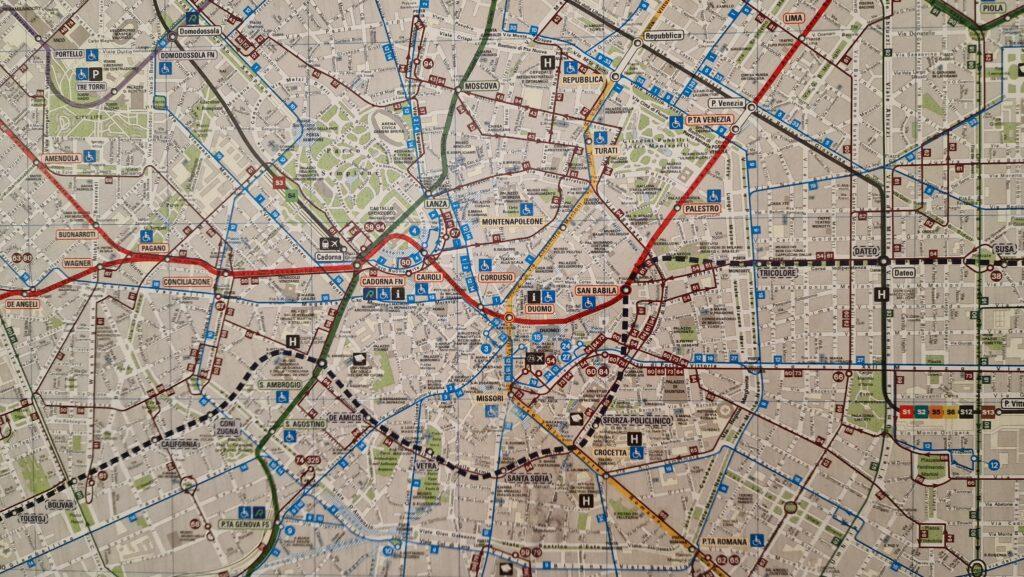
Day trips from Milan by Train
Here are some places that you can comfortably reach by train from Milan for a day trip.
Lake Maggiore
Lake Como
- Varenna: even with direct trains without changes. From Varenna, you can also go to Bellagio by boat.
YouTube Channel
What is the most beautiful lake in Italy? Discover Enchanting Gems
Experience the allure of Italy’s most captivating lake. Uncover enchanting hidden treasures as you delve into the wonders that await. Immerse yourself in the breathtaking beauty showcased in the video featured below. Discover the ultimate day trip destination just a stone’s throw away from Milan. Prepare to be captivated by the unparalleled charm of this Italian gem. Milan things to do will never be the same again.
What is the most beautiful lake in Italy? Discover Enchanting Gems